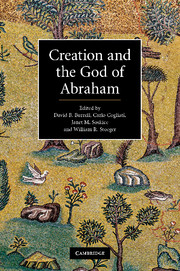Book contents
- Frontmatter
- Contents
- Contributors
- Preface
- Introduction
- 1 Creation ex nihilo: early history
- 2 Creatio ex nihilo: its Jewish and Christian foundations
- 3 The act of creation with its theological consequences
- 4 Scotistic metaphysics and creation ex nihilo
- 5 Creation and the context of theology and science in Maimonides and Crescas
- 6 Creation: Avicenna's metaphysical account
- 7 Four conceptions of creatio ex nihilo and the compatibility questions
- 8 Will, necessity and creation as monistic theophany in the Islamic philosophical tradition
- 9 Trinity, motion and creation ex nihilo
- 10 The Big Bang, quantum cosmology and creatio ex nihilo
- 11 What is written into creation?
- 12 Creatio ex nihilo and dual causality
- 13 God and creatures acting: the idea of double agency
- 14 Thomas Aquinas on knowing and coming to know: the beatific vision and learning from contingency
- Index
Preface
Published online by Cambridge University Press: 07 September 2010
- Frontmatter
- Contents
- Contributors
- Preface
- Introduction
- 1 Creation ex nihilo: early history
- 2 Creatio ex nihilo: its Jewish and Christian foundations
- 3 The act of creation with its theological consequences
- 4 Scotistic metaphysics and creation ex nihilo
- 5 Creation and the context of theology and science in Maimonides and Crescas
- 6 Creation: Avicenna's metaphysical account
- 7 Four conceptions of creatio ex nihilo and the compatibility questions
- 8 Will, necessity and creation as monistic theophany in the Islamic philosophical tradition
- 9 Trinity, motion and creation ex nihilo
- 10 The Big Bang, quantum cosmology and creatio ex nihilo
- 11 What is written into creation?
- 12 Creatio ex nihilo and dual causality
- 13 God and creatures acting: the idea of double agency
- 14 Thomas Aquinas on knowing and coming to know: the beatific vision and learning from contingency
- Index
Summary
Castel Gandolfo, the venerable summer residence of popes, has for over three hundred years been home to the Vatican Observatory. In recent years the Jesuits who run this very ancient and, at the same time, very modern institution have hosted successive gatherings of scholars exploring the interrelations between science and faith. It was during one of these that William Stoeger, S. J., and Janet Soskice got to speaking about creatio ex nihilo. This teaching, central to the theology of the early and medieval Church, is crucial to the traditional doctrine of God and not in any way in tension with modern science, yet its potency and sophistication, we considered, has been strangely overlooked by the modern science and religion dialogue. A conference seemed called for. Creatio ex nihilo has the further advantage of being a place of convergence for all the religions of radical monotheism. Because of this, Bill and Janet immediately thought to ask David Burrell, C. S. C., to be part of the planning team. David was delighted at the opportunity to bring Jewish, Christian and Muslim scholars together – philosophers as well as theologians and scientists. Carlo Cogliati's gracious response to our invitation to be amanuensis for the group assured genial proceedings, as his introduction displays so well.
Our hope was that bringing astute thinkers from Judaism, Christianity and Islam around a common table – some of them old hands at science and religion debates and others not – would help restore the dialectical interaction of faith and reason proper to each of these traditions.
- Type
- Chapter
- Information
- Creation and the God of Abraham , pp. xi - xiiPublisher: Cambridge University PressPrint publication year: 2010



